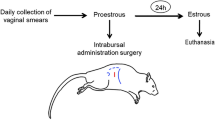Abstract
THE mechanism by which luteinizing hormone stimulates the synthesis of ovarian steroid hormones is the subject of controversy. McKerns1 has proposed that a primary action of this gonadotrophin in rat lutein and bovine corpus luteum cells is to raise the rate of production of reduced nicotinamide–adenine dinucleotide phosphate (NADPH) by a direct stimulation of glucose-6-phosphate dehydrogenase. Savard et al.2 have concluded that luteinizing hormone stimulates steroid production by an effect on protein synthesis following an increase in the intracellular concentration of cyclic-3′, 5′-adenosine monophosphate. If luteinizing hormone acts by increasing the rate of production of NADPH by glucose-6-phosphate dehydrogenase (or some other cytoplasmic NADP-linked dehydrogenase) it should be possible to demonstrate a rise in the tissue concentration of NADPH when steroid synthesis is stimulated. We have made parallel measurements of the concentrations of oxidized and reduced pyridine nucleotides, and the rates of steroid synthesis in lutein tissue taken from rats before and after treatment with luteinizing hormone.
This is a preview of subscription content, access via your institution
Access options
Subscribe to this journal
Receive 51 print issues and online access
$199.00 per year
only $3.90 per issue
Buy this article
- Purchase on Springer Link
- Instant access to full article PDF
Prices may be subject to local taxes which are calculated during checkout
Similar content being viewed by others
References
McKerns, K. W., The Gonads (edit. by McKerns, K. W.), 137 (Meridith Corporation, New York, 1969).
Savard, K., Marsh, J. M., and Rice, B. F., Rec. Prog. Hormone Res., 21, 285 (1965).
Stansfleld, D. A., and Flint, A. P. F., J. Endocrinol., 39, 27 (1967).
Flint, A. P. F., and Denton, R. M., Biochem. J., 116, 79 (1970).
Flint, A. P. F., and Denton, R. M., Biochem. J., 112, 243 (1969).
Eastabrook, R. W., and Maitra, P. K., Anal. Biochem., 3, 369 (1962).
Lowry, O. H., Passoneau, J. V., and Rock, M. K., J. Biol. Chem., 236, 2756 (1961).
Heldt, M. W., Grief, N., Klingenberg, M., Scholz, R., Pauten, U., Grunst, J., Bücher, Th., J. Biol. Chem., 240, 4659 (1963).
Stansfield, D. A., and Robinson, J. W., Endocrinology, 76, 390 (1965).
Flint, A. P. F., and Denton, R. M., Biochem. J., 114, 73P (1969).
Sulimovici, S., and Boyd, G. S., Biochem. J., 103, 16P (1967).
Harding, B. W., and Nelson, D. H., Endocrinology, 75, 501 (1964).
Author information
Authors and Affiliations
Rights and permissions
About this article
Cite this article
FLINT, A., DENTON, R. Mechanism of Action of Luteinizing Hormone. Nature 228, 376–377 (1970). https://doi.org/10.1038/228376a0
Received:
Issue Date:
DOI: https://doi.org/10.1038/228376a0
This article is cited by
-
Mechanism of Action of Luteinizing Hormone
Nature New Biology (1972)
-
Role of Reduced TPN in the Response to Interstitial Cell Stimulating Hormone
Nature (1971)
Comments
By submitting a comment you agree to abide by our Terms and Community Guidelines. If you find something abusive or that does not comply with our terms or guidelines please flag it as inappropriate.



